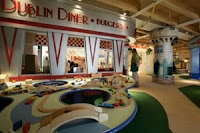Aviva Stadium, a €410 million four level state-of-the art facility opened in May and has a seating capacity of 50,000. Aviva stadium was designed by Populous in conjunction with local Dublin-based Scott Tallon Walker. Populous, one of the world’s leading sports architecture firms, had previously been involved in projects such as Reliant Stadium, Heinz Field, Yankee Stadium, Camden Yards and the Sydney Olympic Stadium.
What an exciting venue to host the Notre Dame v Navy rematch in 2012! The two colleges previously played in Ireland in 1996 when Notre Dame triumphed over Navy in Croke Park. Notre Dame and Navy have played continuously since 1927, making the Notre Dame/Navy rivalry the longest continuous intersectional rivalry in college football.
 “To see this stadium is to believe it has to be one of the finest venues in the world,” said Chet Gladchuk, the Naval Academy Director of Athletics. “Although modest in capacity, few stadiums anywhere has attended to the detail, aesthetics and fan comfort found at Aviva. I guarantee those who travel to Ireland and attend this event will enjoy an experience that will be awesome and a memory not to be forgotten. Navy is very much looking forward to our visit and the wonderful experience we expect our coaches, players, fans and friends will enjoy.”
“To see this stadium is to believe it has to be one of the finest venues in the world,” said Chet Gladchuk, the Naval Academy Director of Athletics. “Although modest in capacity, few stadiums anywhere has attended to the detail, aesthetics and fan comfort found at Aviva. I guarantee those who travel to Ireland and attend this event will enjoy an experience that will be awesome and a memory not to be forgotten. Navy is very much looking forward to our visit and the wonderful experience we expect our coaches, players, fans and friends will enjoy.”
Welcoming the event Aviva Stadium Director, Martin Murphy, said: “We are all delighted that Navy has chosen Aviva Stadium for their game against Notre Dame in 2012”. “We fully realise just how important this game is in the U.S. sporting calendar and we are looking forward to hosting what will undoubtedly be a fantastic event. The selection of Aviva Stadium for this game is a huge endorsement of the stadium and it is a terrific boost for Irish tourism as I have no doubt the teams’ fans will travel in great numbers. We are confident they will have a memorable time in Ireland.”
Be part of the excitement!
Over 12,000 Notre Dame fans traveled from the US to be a part of the 1996 Notre Dame and Navy game. The draw for the 2012 Notre Dame v Navy rematch is expected to be far larger than the 1996 game and seats are filling quickly.
INDIVIDUALS LAND RATES NOW AVAILABLE!
Learn more





















